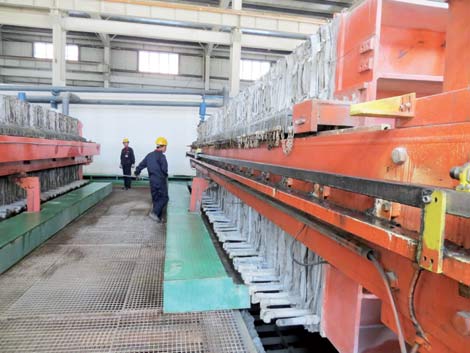Environment
|
 |
|
The treatment workshop at Huatailong's mining project in Jiama. Tibet has 101 kinds of proven reserves, among which many resources such as copper, gold, chromium and boron are in short supply in China. [Photo / China Daily] |
However, Jiama area has an average altitude of 3,900 meters above sea level with the highest place at 5,300 meters, which makes both the mining operation and environmental protection difficult.
"Equipment that operates at high altitudes is more expensive. The cost of social security is more than other projects inland, too," said Chai Liwei, who has worked for Huatailong Mining's safety department for three years in Tibet.
He said the company has spent a lot on environment protection including keeping the water clean and conserving the grass and sparing no effort on minimizing the impact on nature.
In order to protect the grass, the company spent 200 million yuan on an underground ore-delivering tunnel, which is 5.5 kilometers long and varies in height by 397 meters.
The tunnel, the first of its kind in China, can deliver products from the mining area directly to the ore treatment plants. It has an annual delivery capacity of 2 million tons, said Teng Yongqing, general manager of Huatailong.
He said the company spent 15 million yuan on greening projects around the mine in 2011 and a total investment of 200 million yuan since 2007 on road greening, planting projects and drip irrigation facilities.
"National standards require that the environmental protection costs should take up at least 3 percent of the total project investment for mining companies," he said. "Huatailong has spent more than 11 percent, which is much higher than the national requirements."
Since its establishment in 2007, the company has been working on environmental improvements in the Jiama area in order to build the trust of local people and not inconvenience their lives.
The company spent 26.55 million yuan on building a road from the national highway to Jiama and 6 million yuan on planting on both sides of it about 4,000 willow trees that can survive in the plateau area.
It is hard to believe when driving along the road that it is a mining area on the Qinghai-Tibet Plateau because there are more trees than in some parts of Beijing.
The total plantation area covers 155,000 square meters, according to the company, which made records of the survival rate of different species of tree they planted. The survival percentage of some trees such as the willow and redleaf cherry plum was raised from 50 percent to 80 percent in 2012 after professional care.
In April, the company started planting up to 2,000 aspens in the area to create more shade.
